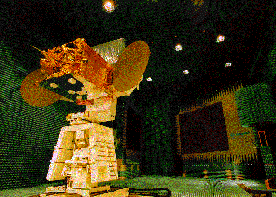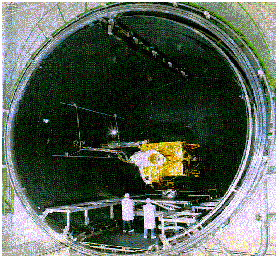|
Here you
are in English version of the site
I work in
space domain and I will present you
tests performed on spacecrafts.

The environmental tests are closely related
to the integration operations and break down into three main categories
:
|
|
1 • THE
ELECTICAL TESTS:
In
addition to the electrical tests and functional tests performed in the
course
of integration from a satellite test bench generally referred to as the
'checkout equipment station', there is a category of environmental
electrical
tests --Electro Magnetic Compatibility tests (E.M.C)-- allowing to
measure and
reduce to a minimum the electromagnetic susceptibility of the specimen
and of
its constituents.
|
|
|

|
|
Antenna
measurements are also electrical tests.
Varying
with the type of the onboard experiment, it may furthermore prove
necessary to
conduct tests to the end of measuring the specimen's magnetic moments
and
achieving its magnetic balancing under specific environmental
conditions said
'out-of-terrestrial magnetic field'.
|

|
|
|
In the specific field of
telecommunications
satellites, most of the technical requirements have recently been
crystallized
by imposing checks on the overall radio-electrical performances at key
points
in the execution of the projects: qualification of the complete
payload, fully
integrated satellite verification tests and final acceptance of the
system.
The telecommunications satellite
programme test plan imposes tests on the antenna subsystem after
integration on
satellite:
- overall
performance measurements on each
antenna, gain measurements, radiation diagram, etc.,
- RF
alignment check,
- END TO END type
measurements
corresponding to full scale simulation of the RF link by generation of
the
uplink and, after frequency and amplification transposition by onboard
transponder system, downlink measurements.
|
|
2 • THE MECHANICAL TESTS :
The
purpose of these tests is to determine the behavior and resistance of
the space
vehicles and equipment, subsystems or systems, all of which being
subject to
conditions as encountered during transportation, propulsion phase
launching and
injection into orbit. As part of the mechanical tests are generally
differentiated two test groups :
|
|
The dynamic tests, which
include:
- The vibrations
tests, the objectives being :
* to analyze
the structures under sinusoidal
conditions, that is to measure the vehicles' dynamic characteristics
(natural
frequencies, resonance mode, resonance factor, etc.),
* to
qualitatively check out materials
resistance to vibrations as induced by the propulsion phase under
conditions
much similar to the environment at launch and this, under random
conditions.
|
|
|

|
|
- The
shocks
tests, which correspond to the shocks caused by transportation,
ignition
and separation of the different launcher's stages. These shocks may
either be
obtained using pyrotechnics or generated on a shaker.
- The
linear acceleration tests, also known as
'static tests', which may
be simulated from actuators or a centrifuge. In general, these tests
are
carried out at structure mock-up level. |
|
|
|
- The
acoustic vibration tests to simulate the
stress produced during the
first minutes of the lift-off during the launch phase. The high level
of
constraints is mainly due to the launcher engines noise reverberated by
the
ground.
The physical measurements,
which include :
- the
measurement of the satellite, equipment
and subsystem mass,
- the center-of-gravity
location,
- the
inertia
moments in relation to the principal axes,
- the
balancing being produced as per the
specimen's guiding and
stabilization requirements.
|
|
3 • THE THERMAL VACUUM TESTS :
The
purpose of these tests is to submit the
satellite and its equipment to in-orbit space storage, climatic and
environmental conditions.
|
|
As a general rule, four test groups
are distinguished :
- The temperature
- humidity tests (of lesser and lesser use).
- The cold/hot
tests, during which the specimen is exposed to storage conditions
and duly
checked for ensuring operation to atmospheric pressure and in-orbit
ultimate
temperatures.
- The 'thermal
vacuum' tests, frequently associated with thermal cycling
tests. They serve, for one, to control the electric circuits'
resistance to
vacuum (Corona effects) and, for the other, to evidence flaws in
thermal
dissipation which is associated with conduction paths (contact
pressure) and
internal radiative coupling conditions. |
|
|

|
|

